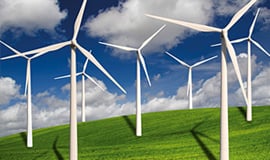Throughout our history, our dedication to quality has meant we’ve used resources wisely by creating products that last. And we’ve had robust performance targets in place to help minimise our impacts on the environment since 2007.
We’re proud to have committed to Net Zero Greenhouse Gas Emissions from operations by 2040. We’ll achieve this by focusing on five broad areas: buying renewable energy in our operations; adopting on-site renewable energy where practical; continuing to increase energy efficiency at our sites; pursuing new technology to sustainably heat our buildings; and converting to a greener vehicle fleet.
And we’ll continue to identify opportunities to minimise any our other environmental impacts across our global business.
Our Net Zero Roadmap
Our Roadmap describes how we currently plan to deliver on our Net Zero commitment.
Please click to download our journey to achieving Net Zero GHG by 2040 from operations.
Buying Renewable Energy for Operations
- We currently procure over 60% of our electricity from renewable (Non GHG producing) sources and our goal is to increase this by 5% over the next three years
- We’re working with our regional utility providers to procure green energy when locally available
Adopting On-site Renewable Energy
- We’re currently evaluating ten sites for the installation of solar electricity and/or combined heat and power
- We have worked with landlords to install onsite renewable electricity, including a recent project in one of our manufacturing plants in China.
Continuing to Increase Energy Effciency at Sites
- We continue to invest in lighting and equipment upgrades with higher efficiency materials and energy use at Smiths facilities worldwide
- We have reduced energy use by 38% since FY2007
Pursing New Technology to Sustainable Heat our Buildings
- Heating our buildings is a significant driver of our remaining emissions
- We’ll explore electric heating using renewable sources where practical and, where fossil fuels are used, we will look at new alternative technologies, efficiencies, and carbon capture
- While we’re not currently aware of an effective way to heat all of Smiths many manufacturing buildings with renewable energy, we won’t stop looking
- We’ll partner with technology providers to drive innovation in this area
Converting to Greener Vehicles
- We’ll look to electrify our small ground fleet as local infrastructure becomes more readily available in various regions of the world


